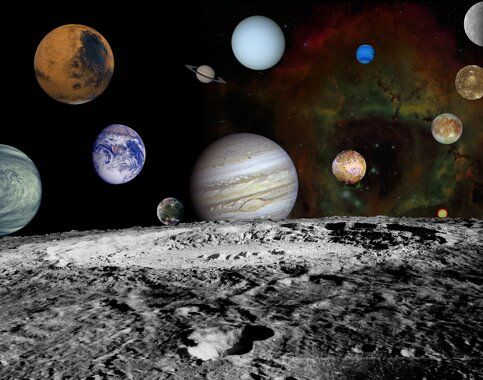
Recently, scientists Michael Brown and Konstantin Batygin from the United States have made a groundbreaking discovery by providing evidence of the existence of a ninth planet in our solar system.
This newly discovered planet was identified through computer modeling, specifically in the study of the movements of small celestial bodies beyond Pluto’s orbit. However, visual confirmation of this planet has not yet been obtained. Preliminary estimates suggest that the mass of this ninth planet is 5-10 times that of Earth, and it may be located up to 200 astronomical units away from the Sun (one astronomical unit is approximately equal to the distance between Earth and the Sun).
For more interesting facts about the planets that make up our galaxy, check out the material on m24.ru.
Mercury
Mercury is the smallest and innermost planet in the Solar System. It is named after the Roman deity Mercury, the messenger of the gods. With a diameter of about 4,879 kilometers, Mercury is the smallest planet in the Solar System, similar in size to Earth’s moon. It is also one of the densest planets in the Solar System, with a core made mostly of iron and a thin rocky mantle. Mercury is known for its extreme temperatures, with highs reaching up to 800 degrees Fahrenheit (430 degrees Celsius) during the day and dropping to -290 degrees Fahrenheit (-180 degrees Celsius) at night. Despite its small size and harsh conditions, Mercury is a fascinating planet to study and has been the subject of numerous space missions, including NASA’s MESSENGER mission, which orbited the planet from 2011 to 2015.

Currently, the smallest planet in our solar system, Mercury, is located closest to the Sun. The oldest records of observing Mercury can be found in ancient Sumerian cuneiform texts dating back to the third millennium BC.
In the geocentric Ptolemaic system, which placed Earth at the center of the solar system, it was believed that the Moon, Sun, Mars, Jupiter, and Saturn orbited around Earth. However, there was no consensus among the ancient Greeks regarding Venus and Mercury.
Mercury is perhaps one of the most unique planets in our solar system. It does not have any natural satellites. It follows a highly elongated elliptical orbit and completes a full revolution around the Sun in just 88 Earth days, making it the fastest planet in our solar system.
Meanwhile, the length of a single sidereal day on Mercury is approximately 59 Earth days, which is more than half of Mercury’s year, making it a unique occurrence in the Solar System.
One other characteristic of the planet is the absence of seasons like those on Earth, as Mercury’s axis of rotation is nearly perpendicular to its orbit. As a result, there are regions near the poles that never receive direct sunlight.
The behavior of the Sun on the planet is also intriguing, as it defies Earth’s norms: after sunrise, it can pause and even reverse its direction, moving from west to east. This is due to the planet’s rotation speed around its axis remaining constant compared to its rotation speed around the sun.

A new planet has been discovered within our solar system
Due to its close proximity to the sun, this planet is exposed to intense heat and light, experiencing temperatures seven times higher than that of Earth. This means that the daytime half of Mercury is constantly scorching. Reports indicate that surface temperatures can exceed 400 degrees Celsius. On the other hand, the night side of the planet experiences extreme cold, with temperatures dropping below minus 200 degrees Celsius.
Mercury’s surface bears a resemblance to the Moon, lacking natural satellites but possessing a very thin atmosphere. The atmospheric pressure on Mercury’s surface is nearly 500 billion times lower than that of Earth. Additionally, it is believed that Mercury has a weak magnetic field, with a strength less than one percent of Earth’s magnetic field.
Observing the planet from Earth is quite challenging due to the small size of its orbit. Although the minimum distance to Mercury is only 80 million kilometers, it is not possible to observe it at this time. This is not only because of the bright light of the Sun, but also because Earth is turned to its night side during this period.
Due to the difficulty of observation, it was long believed that Mercury always faces the Sun with the same side. Medieval astronomical instructions even stated, “Happy is the astronomer who has seen Mercury.”
In 2009, scientists created the first comprehensive map of Mercury using images captured by the Mariner 10 and Messenger spacecraft.
Venus
Venus is the second planet from the Sun in our solar system. It is a rocky planet with a thick atmosphere, making it the hottest planet in our solar system. Venus is often referred to as Earth’s “sister planet” because of its similar size and composition. However, despite these similarities, Venus is a very different place from Earth.
One of the most striking features of Venus is its thick atmosphere. It is composed mostly of carbon dioxide, with clouds of sulfuric acid. This dense atmosphere creates a greenhouse effect, trapping heat and causing the surface temperature to reach scorching levels. The average temperature on Venus is around 900 degrees Fahrenheit (475 degrees Celsius), which is hotter than the surface of Mercury, even though Mercury is closer to the Sun.
The surface of Venus is covered in volcanic plains and large basins, with a few scattered mountains and highlands. There are no oceans or liquid water on Venus, as the extreme heat and pressure would cause any water to evaporate. Instead, the planet has dry riverbeds and channels, which suggest that there may have been water on Venus in the past.
Venus also has a unique rotation pattern. It rotates on its axis in the opposite direction of most planets, including Earth. This means that Venus has a “retrograde” rotation, where the sun rises in the west and sets in the east. Venus also has a very slow rotation, taking about 243 Earth days to complete one rotation. This is longer than its orbital period around the Sun, which is about 225 Earth days.
Despite its harsh conditions, Venus has been a subject of interest for scientists. Space missions, such as NASA’s Magellan mission in the 1990s, have provided valuable data about the planet’s surface and atmosphere. Scientists continue to study Venus to better understand its unique characteristics and its potential for hosting life.

Venus is often referred to as Earth’s sibling due to their similarities in size, gravity, and composition.
However, the similarities end there. Venus has an atmosphere that resembles a thick layer of carbon dioxide gases, which traps heat from the Sun. As a result, the planet experiences constant high temperatures. In fact, the average temperature on Venus reaches a scorching 475 degrees Celsius, making it the hottest planet in our solar system.
Venus is considered relatively young, estimated to be around 500 million years old. It is believed that in ancient times, Venus became so incredibly hot that any Earth-like oceans it may have had completely evaporated, leaving behind a desolate landscape covered in rocks.
The planet’s surface is dotted with numerous volcanoes, with the majority being relatively small, not exceeding 100 meters in height. Due to the planet’s thick cloud cover, telescopes are not able to provide clear visibility of its surface.
However, Venus is easily observable from Earth, as it is much easier to locate in the sky compared to other planets. Venus frequently comes close to Earth, with distances between the two planets sometimes being as little as 45 million kilometers. Additionally, the high cloud density causes the planet to reflect sunlight, giving it a very bright appearance.
Venus is typically visible in the sky shortly before sunrise or after sunset, earning it the names “Evening Star” or “Morning Star”. It is one of the two planets that rotate in a clockwise direction, from east to west, on its axis. Uranus behaves similarly in this regard.
An additional intriguing fact: Venus takes 225 Earth days to complete a revolution around the Sun, and it takes 243 Earth days to complete a full rotation around its axis. This means that a day on Venus is actually longer than a year. Interestingly, due to its slow rotation, Venus does not experience changes in seasons and remains constantly heated on all sides.
Venus holds the distinction of being the first planet (besides Earth) to be observed from space. The unmanned Mariner 2 spacecraft successfully captured images of Venus in December 1962.
Until recently, Venus held the record for being the most frequently visited planet, with 18 Soviet and six American spacecraft having explored its surface. However, Mars has now taken the lead as the most visited planet.
Planet Earth

The third planet from the Sun and our home. It is currently the sole known habitable planet not just within our solar system, but also throughout the entire universe.
It is believed that our planet came into existence approximately 4.7 billion years ago as a result of the accumulation of gas and dust. The emergence of life on Earth is thought to have occurred within the first billion years after its formation.
Various theories propose that asteroid impacts played a significant role in shaping the Earth’s environment and surface, leading to the mass extinction of numerous species. Some even speculate that it was asteroids that brought water, the source of all life, to our planet.
According to different estimations, Earth will continue to maintain the conditions necessary for life for another 0.5-2.3 billion years.
Due to the Earth’s axis of rotation being tilted to the orbital plane, there are unique and noticeable changes in seasons on our planet. The Moon plays a crucial role in stabilizing the tilt of the Earth’s axis and also contributes to gradually slowing down its rotation.
When it comes to the Earth’s water bodies, its oceans and seas hold an astounding amount of 1370 million cubic kilometers of water. To put this into perspective, this volume is equivalent to 10 times the amount of land above sea level.
If you want to witness the beauty of our planet from a different perspective, you have the opportunity to admire the Earth from space through the online ISS website.
Red Planet

Currently, it is Mars that is attracting the most attention from scientists and explorers. Mars is a popular uninhabited planet for various science fiction movie scenarios.
Mars earned its famous nickname, “the red planet,” because of the reddish hue of its surface caused by iron oxide. In addition to the Moon, Mars is the only celestial object that humans can reach using modern rockets and probes. The journey to Mars for astronauts can take approximately four years.
The topography of Mars boasts numerous unique features. In the vicinity of Mars’ equator lies the Tharsis region (also known as the Farsida Province). This area is home to massive volcanoes.
The Tharsis region is home to the largest volcano in the solar system, known as Olympus. It has been reported to be between 21 and 27 kilometers tall, making it the tallest known object in the entire solar system.
An interesting fact about Olympus is that the atmospheric pressure at its summit is only two percent of the pressure on the rest of Mars. To put that into perspective, the pressure at the top of Mount Everest is 25 percent of the pressure at sea level. Since the surface pressure on Mars is 160 times less than Earth’s, the environment at the top of Olympus is nearly equivalent to the vacuum of space.
In close proximity to Tharsis lies the massive Mariner Valley, which is the largest canyon in the entire solar system. It stretches a staggering 600 kilometers wide and is deep enough for Mount Everest to be completely submerged at its lowest point.
It is thought that Mars was once mostly covered by water. Currently, two rovers, Opportunity and Curiosity, are conducting explorations on the Martian surface.
Jupiter

Jupiter, the largest planet in our solar system, has been recognized by humans for centuries. It is mentioned in various ancient cultures, including Mesopotamian, Babylonian, and Greek civilizations.
This gas giant does not have a solid surface and is primarily composed of hydrogen, helium, methane, and ammonia. Jupiter holds the record for having the most number of satellites in our solar system, with a total of 67.
In addition to its satellites, Jupiter also possesses a prominent ring system that is approximately 20,000 kilometers wide. This ring system is located very close to the planet itself. One interesting characteristic of Jupiter is its high rotational speed, which causes it to bulge at the equator. This rapid rotation also generates powerful winds in the planet’s upper atmosphere.
Jupiter, the largest planet in our solar system, has a unique rotation speed. It completes one full revolution on its axis in just 10 hours, making it the fastest rotating planet in our system. However, when it comes to orbiting the Sun, Jupiter takes its time. It takes a whopping 12 Earth years for Jupiter to complete one full orbit around the Sun.
One interesting fact about Jupiter is that it does not have seasons like Earth. This is due to the lack of a solid surface on the planet, which makes it difficult to accurately measure its temperature in one specific location. However, scientists speculate that the temperature at the upper edge of Jupiter’s cloud cover is approximately minus 145 degrees Celsius.
Despite its lack of seasons, Jupiter experiences various atmospheric phenomena similar to those on Earth. The gas giant is known for its powerful storms, lightning, and stunning auroras. What makes these phenomena even more fascinating is their immense size compared to their counterparts on Earth.
One of the most remarkable features on Jupiter is the Great Red Spot, a massive storm that has been raging for over 300 years. This storm is larger than Earth itself, making it a truly awe-inspiring sight in Jupiter’s atmosphere.
The gravity on this massive celestial body is 2.5 times stronger compared to Earth, and it possesses a mass that is also 2.5 times greater than the combined mass of all the other planets in our solar system. Furthermore, Jupiter boasts the most powerful magnetic field among all the planets.
Launched in 2011, the Juno probe is anticipated to arrive at Jupiter within this current year.
The planet Saturn

Famous for its ring system, Saturn is the second largest planet in the solar system. The rings of Saturn are known for their thinness, with a diameter of approximately 250 thousand kilometers and a thickness of less than a kilometer.
Comprised mostly of ice and dust, Saturn’s rings consist of three main rings and a fourth, thinner ring. While all giant planets possess rings, Saturn’s rings are unique in that they can be observed from Earth.
Similar to Jupiter, Saturn lacks a solid surface and is primarily composed of hydrogen with traces of helium. The planet’s density is so low that it is even less dense than water. In fact, all gas giants have such low densities that if there existed a cosmic bathtub in the universe, the gas planets would float within it like soap bubbles.
Due to its rapid rotation, Saturn is compressed at the poles and expanded at the equator. Saturn completes one orbit around the Sun in approximately 29.5 Earth years. Wind speeds near the equator can reach up to 1,800 kilometers per hour, surpassing even the fastest winds on Jupiter.
An intriguing characteristic of Saturn is the presence of a massive hexagonal cloud formation at its north pole, originally discovered by the Voyager spacecraft in the 1980s.
This hexagonal structure remains intact as the clouds rotate, and has remained stable for over 20 years since the Voyager mission, as evidenced by subsequent observations from the Cassini spacecraft.
While individual clouds on Earth can also exhibit a hexagonal shape, the hexagon on Saturn is remarkably symmetrical. Its size is immense, with enough space to accommodate four Earths within its boundaries.
Uranus: The Seventh Planet from the Sun

The solar system is not only home to Earth, but also to another planet with the same blue color – Uranus. This celestial body was first discovered by William Herschel in 1781. Prior to this, Uranus was often mistaken for a regular star when observed in the night sky.
Herschel’s discovery marked a significant milestone in our understanding of the solar system, as it expanded our knowledge beyond what was known since ancient times. Uranus turned out to be a planet full of surprises.
Unlike other gas giants, Uranus and its neighbor Neptune do not have metallic hydrogen at their cores. Instead, they have a significant amount of ice in various temperature states. This unique composition led scientists to categorize Uranus and Neptune as a distinct type of planet known as ice giants.
The main distinguishing feature of Uranus compared to the other celestial bodies is its unique orientation – it spins on its axis in a tilted manner. As a result, Uranus experiences alternating periods of sunlight exposure at its north pole, south pole, equator, and mid-latitudes.
Uranus completes its orbit around the Sun in a span of 84 Earth years. Due to its peculiar tilt, a day at the north pole lasts for half a year, resulting in the north pole being bathed in sunlight for 42 years.
Nevertheless, despite these conditions, Uranus boasts the coldest atmosphere in the entire solar system, with temperatures dropping as low as minus 224 degrees Celsius. It is even colder than Neptune and Pluto, which reside farther away from the Sun.
Interestingly, Uranus’ atmosphere remains remarkably tranquil compared to other colossal planets. This phenomenon is primarily attributed to its relatively low internal heat.
Neptune
Neptune is the eighth and farthest known planet from the Sun in the Solar System. It is the fourth-largest planet by diameter and the third-largest by mass. Among the gaseous planets in the solar system, Neptune is the most dense. It has a rocky core surrounded by a thick layer of hydrogen and helium gases. The planet is famous for its beautiful blue color, caused by the methane in its atmosphere. Neptune has a complex weather system, with strong winds and large storms. It has a faint ring system and many moons, the largest of which is Triton. Neptune was first discovered in 1846 by the French astronomer Urbain Le Verrier, who predicted its existence based on irregularities in the orbit of Uranus.
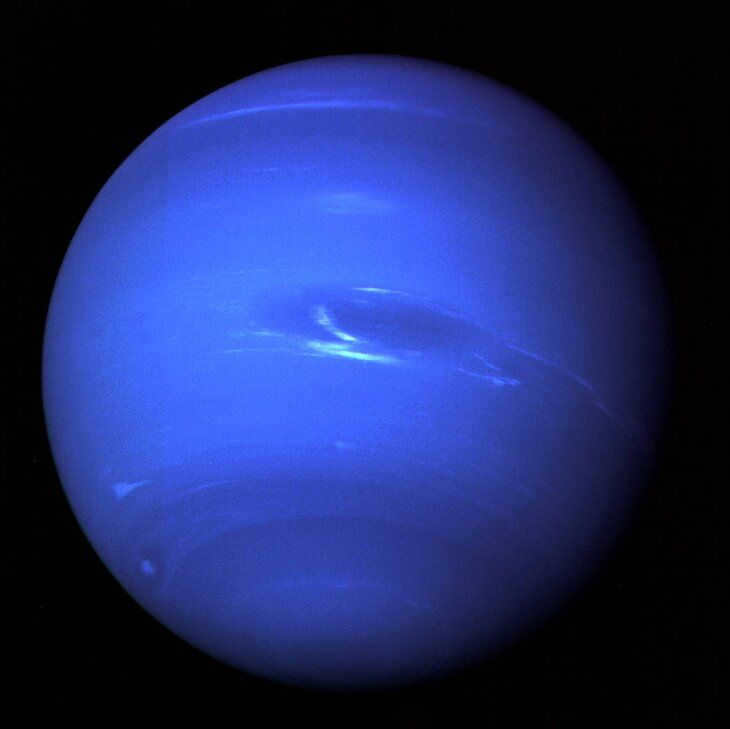
The orbit of the eighth planet in our solar system intersects with Pluto’s orbit at multiple points, resulting in a fascinating phenomenon. For nearly 20 years out of its 248-year orbit, Pluto is actually within the orbit of Neptune.
Neptune, the smallest of the gas giants, was officially discovered on September 23, 1846. Interestingly, it was the first planet to be found using mathematical calculations rather than continuous observations.
Despite its significance, Neptune cannot be seen with the naked eye from Earth. The only spacecraft to have ever visited the planet was Voyager 2, which conducted a close flyby on August 25, 1989.
Neptune has the most powerful winds among all the planets in the solar system, with speeds that can reach up to 2100 kilometers per hour, as estimated by some sources.
Interestingly, just recently, on July 12, 2011, exactly 165 Earth years had passed since Neptune was first discovered.
Pluto
Pluto, also known as the dwarf planet, is a celestial body that orbits the Sun in the outer region of the Solar System. It was discovered in 1930 and was considered the ninth planet of the Solar System until 2006 when it was reclassified as a dwarf planet by the International Astronomical Union. Despite its small size and distant location, Pluto has been a subject of interest and study for astronomers.
Pluto has a unique and complex geography. It has a rocky core surrounded by a layer of ice, which gives it a distinctive appearance. Its surface is covered with nitrogen ice, methane ice, and carbon monoxide ice, giving it a reddish-brown color. It also has a thin atmosphere composed mainly of nitrogen, with traces of methane and carbon monoxide.
One of the most fascinating features of Pluto is its moon, Charon. Charon is about half the size of Pluto and is locked in a synchronous orbit with it, meaning that it always shows the same face to Pluto. This has led to the formation of a tidal bulge on Pluto, causing its shape to be slightly elongated.
The study of Pluto has been greatly advanced by space missions. In 2015, NASA’s New Horizons spacecraft made a flyby of Pluto and provided detailed images and data about its surface and atmosphere. This mission revealed many surprising features, including a heart-shaped region on Pluto’s surface called Tombaugh Regio.
Despite its reclassification, Pluto remains an object of fascination and study. Its unique characteristics and its position as the largest known object in the Kuiper Belt make it an important subject for further research. As scientists continue to learn more about Pluto, they hope to gain a deeper understanding of the formation and evolution of the Solar System.

Despite no longer being officially recognized as a planet for the past decade, it is impossible to overlook Pluto. Once considered the ninth planet in our solar system, it is now known as the largest dwarf planet.
From its discovery in 1930 until 2006, Pluto held the status of the ninth planet in our solar system. However, as the late 20th and early 21st centuries progressed, numerous larger objects than Pluto were found in the outer reaches of the solar system, specifically in the Kuiper Belt.
Furthermore, in 2006, the International Astronomical Union established a precise definition of what constitutes a planet, a definition that did not include the relatively small Pluto. As a result, it was classified as a “dwarf planet” and given the official designation of 134340.
Pluto’s demotion from planet status has given rise to some intriguing facts. The American Dialectological Society officially recognized the word “to pluto” in 2006, which means “to downgrade someone or something in terms of rank or value, just like what happened to the former planet Pluto.”
Moreover, in 2007, the New Mexico state legislature, where Clyde Tombaugh, the discoverer of Pluto, resided, unanimously decided that Pluto would forever be regarded as a planet in their skies as a tribute to him. Two years later, the Senate of Illinois, Tombaugh’s home state, passed a similar resolution.
Despite the controversy, some scientists continue to classify Pluto as a planet due to its distinct atmosphere, seasonal changes, polar caps, and satellites.

NASA has recently released a collection of extraordinary photographs taken from the surface of Pluto.
In the year 2015, after a nine-year journey, the American spacecraft New Horizons successfully reached Pluto and conducted a thorough exploration of the planet. Interestingly, the spacecraft carried a small portion of the ashes of Clyde Tombaugh, the astronomer who discovered Pluto.
Pluto stands out as the only known dwarf planet in our solar system that possesses a distinct atmosphere. Composed predominantly of rock and ice, Pluto is remarkably small in size, comparable to the surface area of Russia.
Remarkably, Pluto has the longest orbital period among all the planets in our solar system, with a complete revolution around the Sun taking approximately 248 Earth years.
The rotation of Pluto causes the Sun to rise and set approximately once every week, resulting in sunlight reaching its surface in a span of five hours. This is a stark contrast to Earth, where it only takes eight minutes for a sunbeam to reach the surface. Furthermore, the intensity of sunlight on Pluto is two thousand times weaker compared to Earth.
- Venus holds the title for being the hottest planet in our solar system.
- On the other hand, Uranus takes the crown for being the coldest planet.
- When it comes to wind speeds, Neptune ranks as the windiest planet.
- Mars boasts the highest mountains among all the planets.
- Earth has the highest density of all the planets.
- Mercury experiences the most extreme temperature difference between day and night.
- Jupiter takes the title for being the fastest planet in terms of rotation.
- Lastly, Saturn has the lowest density among all the planets.

Despite its apparent disorder, the vast expanse of the cosmos is actually a finely-tuned structure. This immense realm is governed by the unchanging laws of physics and mathematics. Every object, no matter how small or large, has its designated place and follows its prescribed orbit or trajectory. This intricate order has been in place for over 15 billion years, since the inception of the universe. Our solar system, the bustling metropolis of the cosmos that we call home, is no exception.

Despite its vast size, the Solar System can be comprehended by humans as it has been extensively studied and has clearly defined boundaries.
Origin and fundamental astrophysical parameters
In a universe where an infinite number of stars exist, it is undeniably possible for other solar systems to exist. In our own Milky Way galaxy, there are an estimated 250-400 billion stars, so it is not impossible for there to be other worlds with different forms of life deep within the vastness of space.

In the not-so-distant past, humans possessed only a limited knowledge of the vast expanse of the universe. Their understanding was confined to what they could observe through the lenses of telescopes. The celestial bodies of the Sun, Moon, planets, comets, and asteroids were the only known entities, and the entirety of the cosmos was measured by the size of our own galaxy. However, the dawn of the 20th century brought about a profound shift in this understanding. Through astrophysical research and the groundbreaking work of nuclear physicists, scientists have gained insights into the origins of the Universe. We now have a grasp on the processes that gave rise to stars and provided the materials necessary for the formation of planets. With this knowledge, we are able to comprehend and explain the origins of our very own solar system.
The Sun, along with other celestial bodies, originated from the Big Bang event, which triggered the formation of stars across the vast expanse of space. Various objects, both large and small, emerged as a result. In a particular sector of the Universe, amidst a group of stars, our Sun came into existence. In cosmic terms, our star is relatively young, with an age of merely 5 billion years. At its birthplace, a colossal construction site materialized, where the gravitational compression of a gas and dust cloud led to the formation of other entities within the solar system.
Each celestial object assumed its unique form and occupied its designated space. Certain celestial bodies, influenced by the gravitational pull of the Sun, became permanent satellites, following their own distinct orbits. Meanwhile, other entities ceased to exist as a result of the opposing forces of centrifugal and centripetal processes. This entire transformative journey spanned approximately 4.5 billion years. The total mass of the solar system amounts to 1.0014 M☉, with the Sun itself accounting for 99.8% of this mass. The remaining 0.2% is composed of other cosmic entities such as planets, satellites, asteroids, and fragments of cosmic dust that orbit around it.
The solar system’s orbit is almost circular, with a velocity that matches that of the galactic spiral. As the solar system travels through the interstellar medium, it relies on the gravitational forces within our galaxy to maintain stability. This stability, in turn, impacts other objects and bodies within the solar system. The solar system’s movement occurs at a significant distance from the highly dense star clusters in our galaxy, which pose potential risks.

When it comes to its size and the number of satellites it possesses, our solar system is far from being considered small. In the vast expanse of space, there exist solar systems that are much smaller, consisting of only one or two planets, barely noticeable amidst the cosmic abyss. Our Sun’s star system, on the other hand, is a massive celestial entity, hurtling through space at an astonishing speed of 240 km/s. Despite its rapid pace, the solar system manages to complete a full revolution around the galaxy’s center every 225-250 million years.
As for its precise location in the intergalactic realm, our star system can be identified as follows:
- The local interstellar cloud
- A local bubble in the Orion-Swan arm
- The Milky Way galaxy, a member of the Local Group of galaxies
Solar System Representation
The star at the center of our solar system, known as the Sun, is part of the vast Milky Way Galaxy which consists of approximately 100 billion stars. It is classified as a medium-sized star belonging to the G2V spectral class, specifically categorized as a Yellow Dwarf. The Sun has a diameter of about 1,392,000 kilometers and is currently in the middle stage of its life cycle.

Comparatively, Sirius, which is the most luminous star, measures approximately 2,381,000 kilometers in diameter. Aldebaran boasts a diameter of nearly 60,000,000 kilometers. The colossal star Betelgeuse is 1,000 times the size of our Sun. In fact, this supergiant exceeds the dimensions of the entire solar system.
Proxima Centauri, the nearest neighbor to our star, would require approximately 4 years of travel at the speed of light to reach.
Due to its immense mass, the Sun holds a group of eight planets in its vicinity, and many of these planets have their own satellite systems. The Solar System diagram clearly illustrates the arrangement of objects orbiting the Sun. Almost all of the planets in the Solar System travel in the same direction around our star, in sync with its rotation. These planets have orbits that are nearly coplanar, but they vary in shape and speed as they revolve around the system’s center. The movement around the Sun is counterclockwise and confined to the same plane. However, comets and other objects, primarily found in the Kuiper belt, have orbits that deviate significantly from the ecliptic plane.
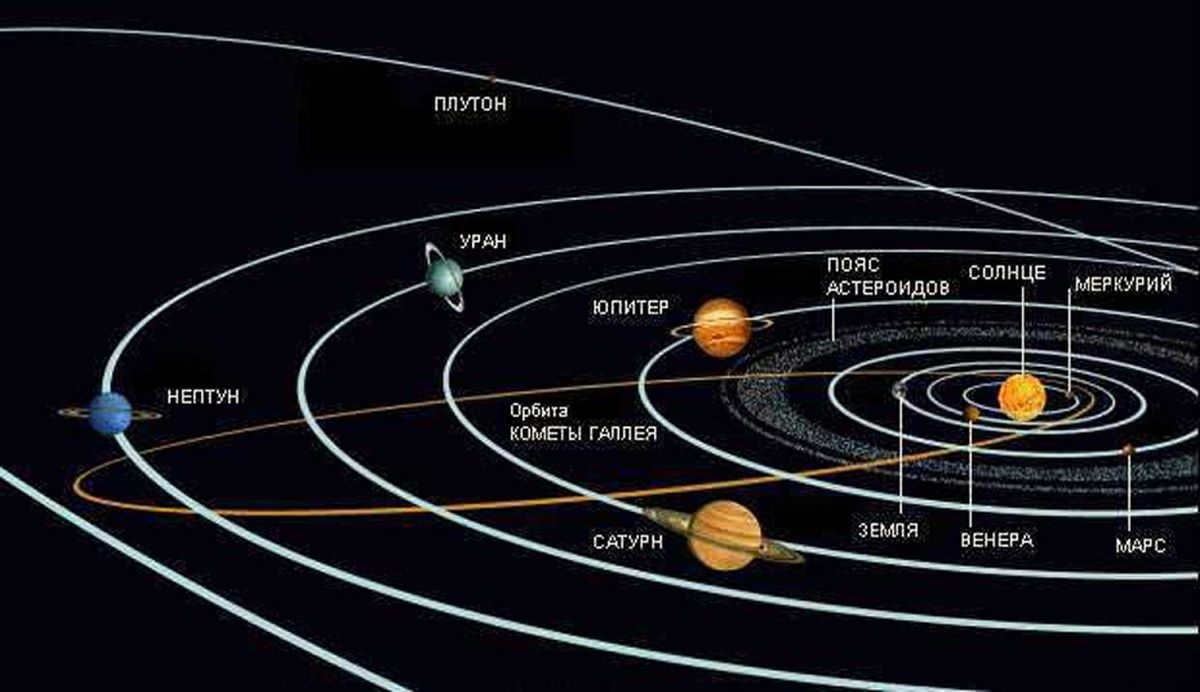
In the present day, we possess precise knowledge regarding the quantity of planets that constitute our solar system. There are a total of eight planets. Each of these celestial bodies, situated at varying distances from the Sun, undergo periodic movements of either drawing nearer or receding. Consequently, each planet possesses its own unique astrophysical parameters and characteristics, distinguishing it from its counterparts. It is worth noting that six out of the eight planets within the solar system rotate in the same direction as the Sun does around its own axis. Only Venus and Uranus exhibit a rotational direction contrary to this. In addition, Uranus stands as the sole planet in the solar system that is practically tilted on its side, with its axis inclined at a 90-degree angle to the ecliptic line.

Nicolaus Copernicus introduced the initial representation of the solar system. According to his theory, the Sun occupied the central position in our universe, with the other planets, including Earth, orbiting around it. Subsequently, Kepler, Galileo, and Newton made advancements to this model by aligning the celestial bodies within it based on mathematical and physical principles.
When you observe the model presented, you can envision that the space objects’ orbits are evenly spaced from one another. However, the actual nature of the Solar System presents a different picture. As the planets in the Solar System move farther away from the Sun, the distance between their orbits increases. The table displaying the distances of objects from the center of our star system enables us to visualize the vast scale of the Solar System.

The speed of rotation of the planets around the center of the solar system decreases as the distance from the Sun increases. Mercury, which is the nearest planet to the Sun, completes one orbit around our star in only 88 Earth days. On the other hand, Neptune, which is located 4.5 billion kilometers away from the Sun, takes 165 Earth years to complete one revolution.
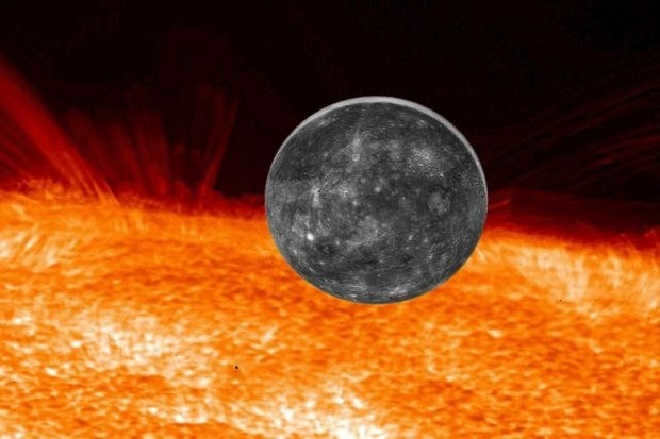
Even though we are discussing a heliocentric model of the solar system, numerous planets possess their own systems comprising of moons and rings. The moons of the planets revolve around their parent planets and adhere to the same laws.
A majority of the moons in the solar system orbit their planets synchronously, always presenting one side to them. This is also true for the Moon, which always presents one side to Earth.
Mercury and Venus are the only two planets without any natural satellites. In fact, Mercury is even smaller in size than some of the moons.
The hub and perimeters of the solar system
The primary and pivotal entity within our system is the Sun. It boasts a multifaceted composition, with hydrogen comprising 92% of its mass. The remaining 7% is composed of helium atoms, which, upon interacting with hydrogen atoms, serve as the propellant for an unceasing nuclear chain reaction. Nestled within the heart of the star lies a core measuring 150-170 thousand kilometers in diameter, scorching with temperatures reaching a staggering 14 million K.


The boundary of our star’s domain is the Kuiper belt and the Oort cloud. These are incredibly distant areas of space that are influenced by the Sun. Within the Kuiper Belt and the Oort Cloud, there exists a multitude of objects of varying sizes, all of which in some way impact the processes occurring within the Solar System.
The Oort Cloud is a theoretical spherical expanse that surrounds the entirety of the Solar System. This region of space is located more than 2 light years away. It serves as the abode of comets. It is from this celestial neighborhood that these uncommon cosmic visitors, known as long-period comets, make their way to us.
The Kuiper belt is home to a concentration of residual material that played a role in the formation of our solar system. This area is primarily composed of small particles of icy space debris, including frozen gases such as methane and ammonia. Additionally, there are larger objects present, including dwarf planets and smaller fragments with asteroid-like structures. Notable examples of dwarf planets within the Kuiper belt include Pluto, Haumea, and Makemake. These objects are located at a distance that can be traversed by a spacecraft within a single light-year.
Adjacent to the Kuiper belt, on its outermost fringes, lies a sparsely populated region consisting primarily of remnants of space ice and gas.
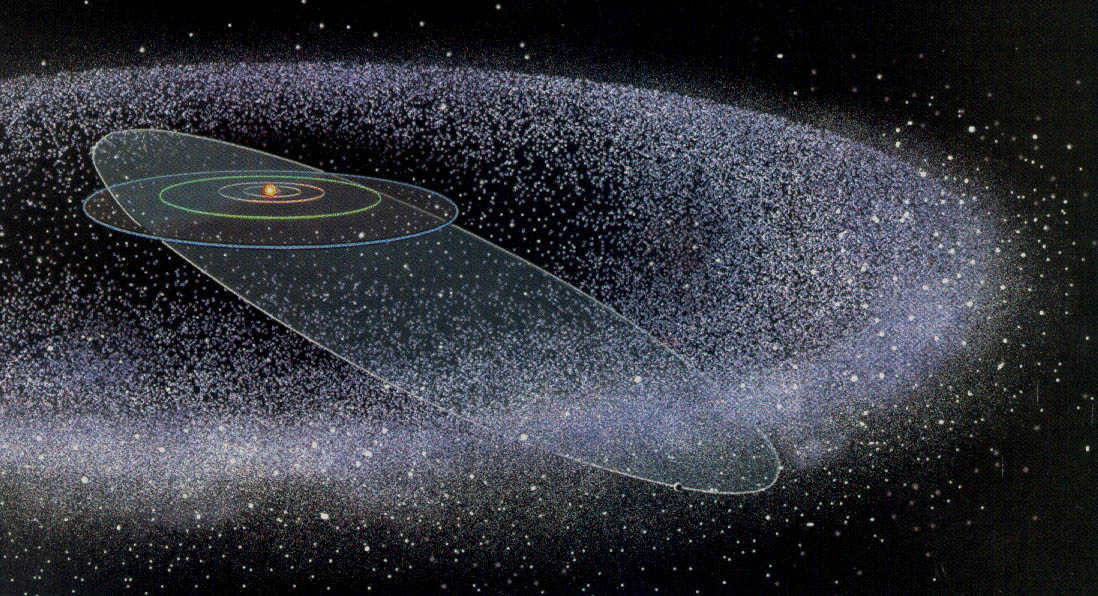
Up to now, the presence of significant celestial bodies beyond Neptune in this area of our star system has been acknowledged, one example being the dwarf planet Sedna.
A concise overview of the planets in the solar system
Scientists have determined that the combined mass of all the planets in our star system is less than 0.1% of the Sun’s mass. Nevertheless, even within this small amount, 99% of the mass is attributed to the two largest celestial bodies following the Sun – the planets Jupiter and Saturn. The sizes of the planets in the solar system differ greatly. Among them, there are both small and giant planets that share similar structures and astrophysical parameters with failed stars.
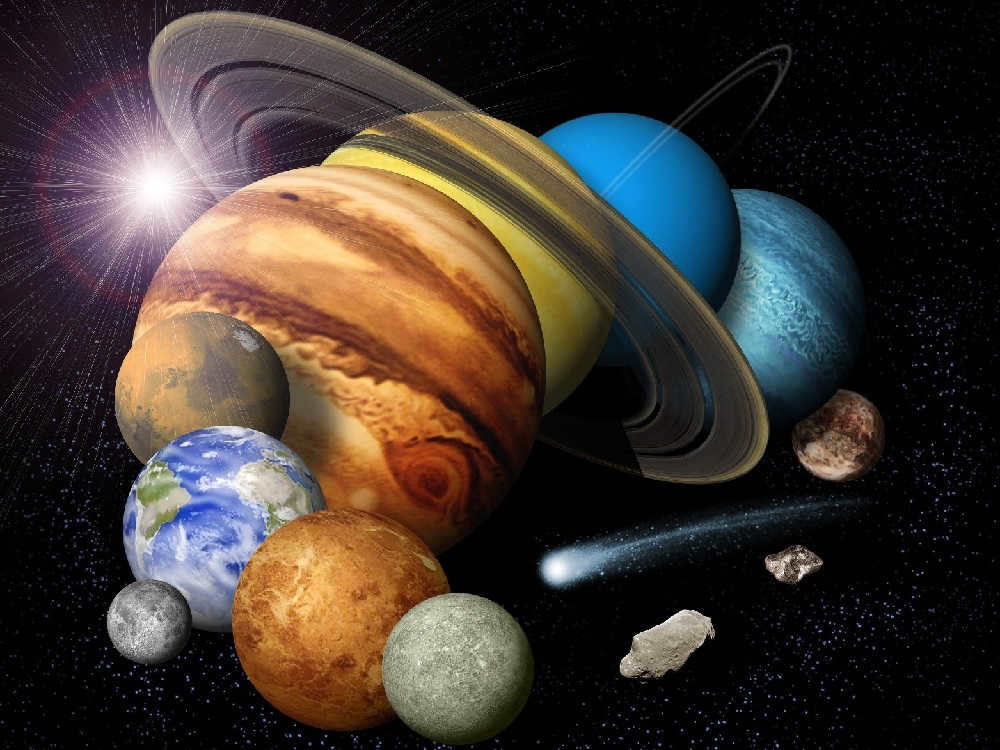
When it comes to astronomy, the 8 planets in our solar system are typically divided into two groups:
- The planets with a solid composition are part of the Earth group;
- The planets that are dense masses of gas belong to the gas giant group.
In the past, it was believed that our star system consisted of 9 planets. However, it was only in the late 20th century that Pluto was reclassified as a dwarf planet in the Kuiper belt. Therefore, we can confidently say that there are now eight planets in the solar system.

If we arrange the planets of our solar system in a specific order, the diagram of our cosmic neighborhood will appear as follows:
- Mercury;
- Venus;
- Earth;
- Mars;
- Jupiter;
- Saturn;
- Uranus;
- Neptune.
In the midst of this parade of celestial bodies lies the asteroid belt. Scientists believe that these fragments are the remnants of a planet that existed during the early stages of our solar system, but perished due to a cataclysmic cosmic event.
The inner planets Mercury, Venus, and Earth are the nearest celestial bodies to the Sun, making them highly reliant on the activities taking place on our star. A little further away, we find the ancient God of War, the planet Mars. These four planets share similarities in terms of structure and astrophysical parameters, which classifies them as part of the Earth group of planets.

Mercury, which is situated close to the Sun, can be described as a scorching hot frying pan. It is intriguing to note that despite its proximity to the fiery star, Mercury experiences the most significant temperature fluctuations within our solar system. During the daytime, the planet’s surface reaches a scorching 350 degrees Celsius, while at night, it plunges into the frigid cold with a temperature of -170.2 °C. Venus, on the other hand, is akin to a boiling cauldron with extreme pressure and high temperatures. Despite its bleak and dreary appearance, Mars has recently captured the attention of scientists. Its atmospheric composition, astrophysical parameters resembling those of Earth, and the presence of distinct seasons offer hope for future exploration and potential colonization by inhabitants of Earth.

Gas giants are fascinating for their moons, as these satellites could potentially harbor life under specific conditions, according to scientists. These moons could potentially serve as space territories where life could emerge.
The planets in the Earth group are separated from the four gas planets by the asteroid belt, which acts as the boundary between them and the realm of the gas giants. Adjacent to the asteroid belt is Jupiter, which serves as a gravitational balance within our solar system. Jupiter is the largest, most massive, and densest planet in our solar system, with a diameter of 140,000 kilometers, five times that of Earth. This gas giant also possesses its own system of satellites, consisting of approximately 69 moons. Notably, Ganymede and Callisto, the two largest satellites of Jupiter, are even larger than the planet Mercury.

Jupiter’s sibling, Saturn, also possesses an immense size, measuring 116 thousand kilometers in diameter. What sets Saturn apart in the night sky is its stunning system of rings encircling the planet. Additionally, Saturn boasts an impressive entourage of 62 satellites. Among these satellites, Titan reigns as one of the largest in the entire solar system, with a diameter exceeding 10 thousand kilometers. Despite its grandeur, Titan’s inhospitable environment of hydrogen, nitrogen, and ammonia precludes the existence of any known life forms. In contrast to their host planet, Saturn’s satellites possess rocky compositions and solid surfaces. Moreover, some of these satellites even possess atmospheres, with Enceladus being speculated to harbor water.
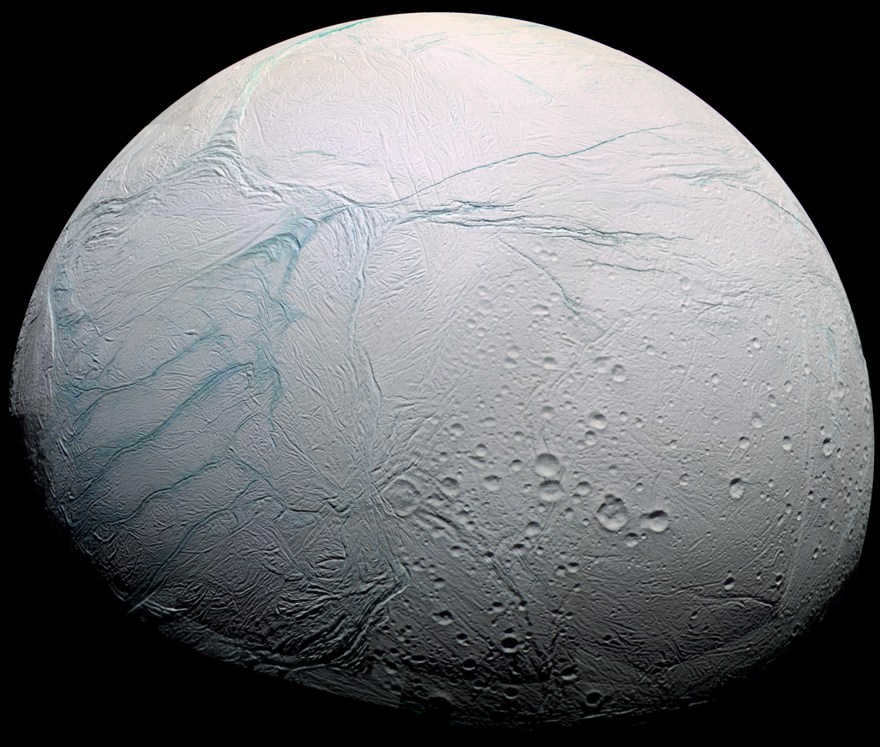
The giant planets Uranus and Neptune are part of the outer solar system. These planets have a different composition compared to Jupiter and Saturn, with methane and ammonia dominating their atmospheres instead of hydrogen. In addition, Uranus and Neptune have a unique feature – high-temperature ice. Because of these characteristics, they are often classified as “ice giants”. Uranus is the third largest planet in the solar system, after Jupiter and Saturn, while Neptune has an orbit with a diameter of nearly 9 billion kilometers. It takes Neptune approximately 164 Earth years to complete one orbit around the Sun.
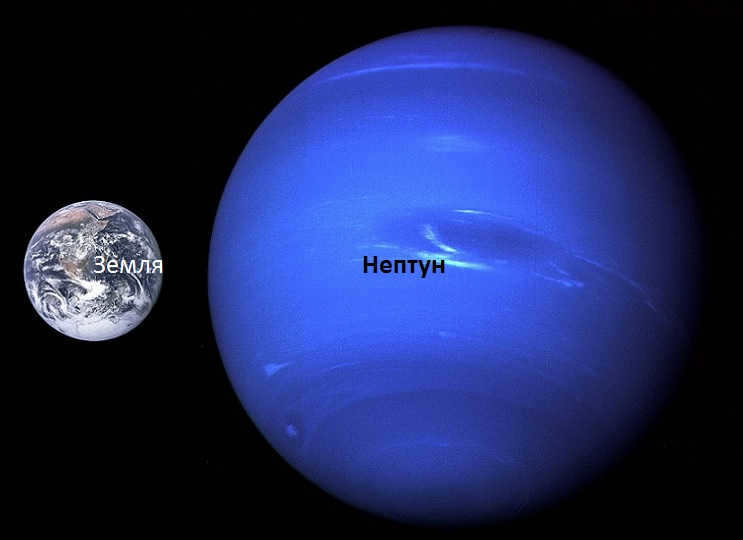
Mars, Jupiter, Saturn, Uranus, and Neptune are currently the most captivating celestial bodies for scientists to investigate.
The most recent updates
Despite the vast amount of knowledge that humanity possesses today and the advancements in observation and research methods, there are still numerous unanswered questions. What is the actual composition of the Solar System? Which of the planets might potentially support life in the future?

Mankind continues to observe the closest area of space, making an increasing number of fresh discoveries. In December 2012, the entire planet had the opportunity to witness a captivating astronomical performance – a parade of planets. During this period, all seven planets of our solar system were visible in the night sky, including even the remote ones like Uranus and Neptune.
A closer examination is currently being conducted with the aid of automated space probes and spacecraft. Many of them have already successfully reached the outermost regions of our star system and even ventured beyond it. The first man-made objects to reach the outskirts of the Solar System were the American probes Pioneer-10 and Pioneer-11.


It is fascinating to speculate about the potential of these spacecraft to venture beyond the limits. Voyager 1, which was launched in 1977, holds the distinction of being the inaugural probe to exit our solar system after four decades of planetary exploration.
The solar system encompasses Earth and the other planets that revolve around the Sun. Moreover, it is a constituent element of the Milky Way Galaxy.

The arrangement of the solar system refers to the organization of celestial objects within it. It consists of a central star, known as the Sun, and various celestial bodies that revolve around it.
These celestial bodies encompass the planets, their moons, asteroids, comets, and the dust particles that exist between them.
Astronomical Bodies
The universe is comprised of various astronomical bodies, each with its own unique characteristics. One such type of celestial body is a planet, which orbits around a star and possesses a significant mass, as well as a generally spherical shape.
Definition: A planet is a celestial body that revolves around a star, exhibiting a considerable mass and a nearly spherical form.
What sets planets apart from stars is their inability to emit their own light. Instead, they rely on reflecting the light emitted by stars.

Clusters of celestial bodies
Astronomers have identified a total of 8 celestial bodies that constitute the solar system. These celestial bodies can be categorized into two distinct clusters:
The first cluster, known as the Earth group, comprises of Mercury, Venus, Earth, and Mars. These celestial bodies are relatively diminutive in size and possess a limited number or absence of natural satellites.

Jupiter, Saturn, Uranus, and Neptune are the four massive planets in our solar system. These planets boast immense sizes, magnificent rings, and a plethora of satellites.

Dwarf planets also have their own unique characteristics. These celestial bodies are in orbit around the Sun, possess a nearly spherical shape, and are not classified as satellites of any other planets.
Planets of the Earth group
The terrestrial planets, which include Mercury, Venus, Earth, and Mars, are the closest to the Sun. These planets have solid surfaces and rotate at a slower rate on their axis. They are positioned in the inner region of the Solar System, situated between the Sun and the asteroid belt.
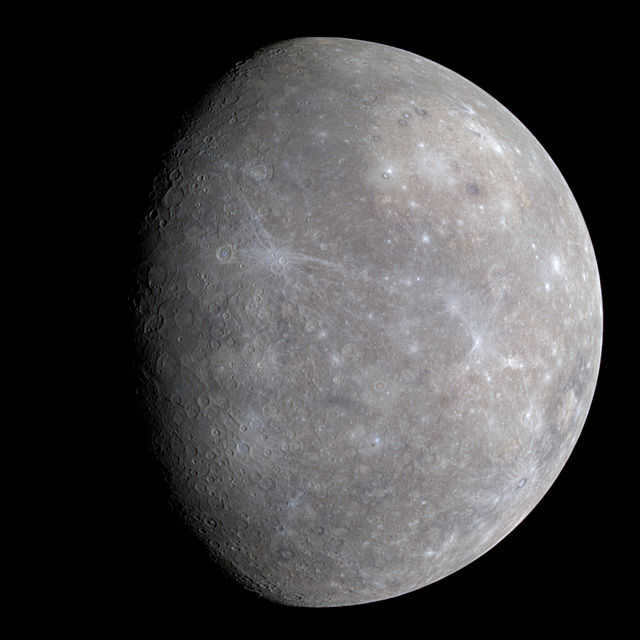
Mercury is the planet that is closest to the Sun and also happens to be the smallest. It is quite challenging to observe Mercury due to the interference of the Sun’s rays. This planet lacks an atmosphere and does not have any natural satellites. The temperature on its surface experiences extreme fluctuations, ranging from +430 °C during the day to -170 °C at night.
Venus is the second planet in our solar system, located between Mercury and Earth. Often referred to as Earth’s sister planet, Venus is slightly smaller than Earth. One unique characteristic of Venus is its retrograde rotation, which means it rotates in the opposite direction to most other planets. The planet is known for its dense atmosphere, composed mainly of carbon dioxide. This thick layer of clouds obscures much of the sunlight, resulting in a dim and hazy appearance. The average surface temperature on Venus is a scorching +464 °C, making it the hottest planet in our solar system. Unlike Earth, Venus does not have any natural satellites, such as a moon. The planet’s surface is characterized by both mountains and plains.

The Earth is the third planet from the Sun, and it is the largest among the group of planets in the Solar System. It ranks fifth in terms of size. Additionally, the Earth is unique because it is the only planet in our system that supports life. Furthermore, it has a natural satellite called the Moon.
Mars, on the other hand, is the fourth planet from the Sun. When observed from Earth, it appears as a reddish-brown celestial body. According to data collected by spacecraft, the surface of Mars is a barren desert covered with reddish sand and rocks. Scientists have also discovered dried riverbeds, indicating that water was once present on the planet. The poles of Mars are characterized by ice caps. The temperature on the planet’s surface can range from +35 °C to -153 °C. Furthermore, the atmosphere of Mars is very thin and primarily composed of carbon dioxide. In addition to these features, Mars has two satellites named Phobos (meaning “fear”) and Deimos (meaning “terror”).

Enormous planets
The enormous planets consist of Jupiter, Saturn, Uranus, and Neptune. They are massive gas entities with a solid nucleus. They are significantly larger than the rocky planets. To illustrate, Jupiter, the most massive gas giant, has a volume 1321 times that of Earth.
Enormous planets spin rapidly on their axis, possess rings, and numerous moons.
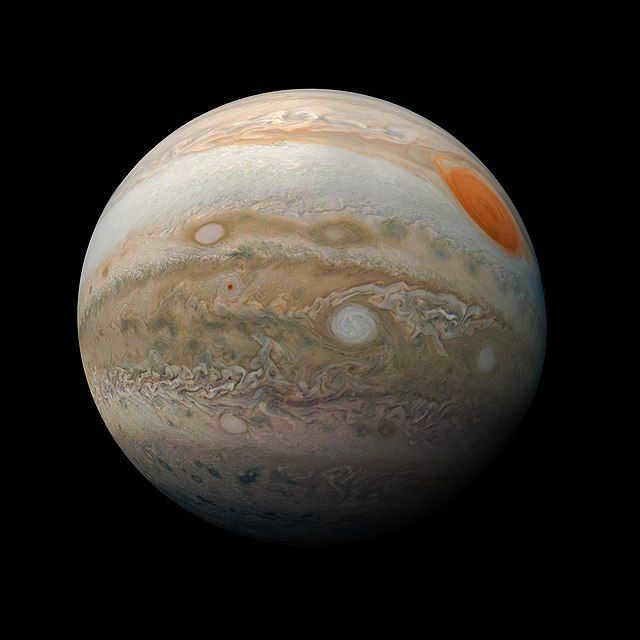
Jupiter is the largest planet in the solar system, located fifth from the Sun. Even if you combine the sizes of all the other planets, Jupiter still surpasses them in size. The atmosphere of Jupiter consists of extensive layers of clouds, giving it a striped appearance. The upper layer of these clouds has a temperature of -133 °C. The rings of Jupiter are composed of tiny dust particles. The gas giant is surrounded by 95 satellites, with Ganymede being the largest satellite in the entire solar system.
Saturn is the sixth planet from the Sun and the second largest planet in our Solar System. What makes Saturn unique among the other planets is its stunning rings. Scientists believe that these rings are made up of ice particles. The upper layer of Saturn’s clouds has a temperature of -140 ° C. Saturn also has a total of 145 satellites orbiting around it, with the largest one being Titan, which is the second largest moon in our entire solar system, just behind Ganymede.

Uranus is positioned as the seventh planet from the Sun. Similar to Venus, Uranus demonstrates a unique rotation direction compared to the other celestial bodies. The upper cloud layer of Uranus maintains a frigid temperature of -197 °C. Due to its significant axial tilt, Uranus appears to be “lying on its side” as it revolves around the Sun. The planet is surrounded by delicate dust rings and is accompanied by 27 satellites. Notably, Uranus was the first planet to be discovered using a telescope.
Neptune holds the distinction of being the most distant planet from the Sun within our solar system, as well as being the smallest of the giant planets. This celestial body boasts a cloud cover and is adorned with its own set of rings. Additionally, Neptune is accompanied by 14 satellites. The upper layer of the planet maintains a chilling temperature of -200 °C.

The planets Uranus and Neptune have a similar size. They differ greatly from Jupiter and Saturn, and cannot be seen with the naked eye from Earth. Uranus and Neptune are often referred to as “ice giants” due to their extremely low temperatures.
Do you know which planet was first discovered using mathematical calculations?
Neptune’s existence was actually predicted in advance through mathematical calculations based on the laws of physics. Astronomers were provided with the exact coordinates in the night sky and the anticipated time of its appearance in 1846. Using a powerful telescope, Neptune was then discovered on the very first night of observations.
Etymology of the planet names
In the realm of celestial bodies, the planets in our solar system bear the names of revered deities from the rich tapestry of ancient Roman and Greek mythology.
| Mercury | In Roman mythology, the god who presides over commerce, profit, and enrichment. |
| Venus | In Roman mythology, the goddess associated with beauty, love, fertility, and prosperity. |
| Mars | The deity of war in Roman mythology. |
| Jupiter | In Roman mythology, the god who rules over the sky, daylight, thunderstorms, and is considered the father of all gods, the supreme deity of the Romans. |
| Saturn | The god associated with agriculture in ancient Roman mythology. |
| Uranus | The ancient Greek god associated with the sky. |
| Neptune | The god of the sea in ancient Roman mythology. |
Small celestial bodies
Small celestial bodies, as their name suggests, are significantly smaller compared to their larger counterparts. The international scientific community has identified several celestial bodies that fall into this category, including Ceres, Makemake, Haumea, Erid, and Pluto. It is worth noting that Pluto, once considered the ninth planet, was reclassified as a small celestial body in 2006.
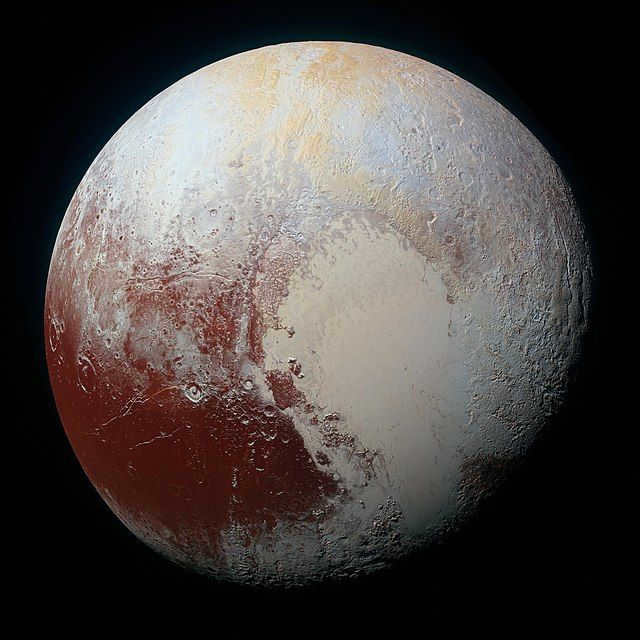
Frequently Asked Questions
A frequently asked question is what is a solar system? A solar system is a region of space with the Sun at its center, where the planets with their satellites and other celestial bodies move.
What sets the inner planets apart from the outer planets? The inner planets, which include Mercury, Venus, Earth, and Mars, are closest to the Sun. They have solid surfaces, are small in size, rotate more slowly on their axis, and have few or no satellites.
Which planet is the closest to the Sun? The smallest planet closest to the Sun is Mercury. On the other hand, Neptune is the furthest away.
What is Saturn known for? Saturn is known for its impressive collection of satellites. There are over 145 satellites orbiting around it, with the largest one being Titan.
Is Pluto considered a planet? No, since 2006, Pluto has not been considered a planet by the International Astronomical Union. Instead, it is classified as a dwarf planet.

The solar system consists of a group of planets that revolve around a central star known as the Sun. The Sun is not only a source of energy, but also provides heat and light to the planets. It is believed that the Sun and the Solar System were formed approximately 4.5 billion years ago as a result of the explosion of one or more supernovae. Initially, the Solar System was a cloud of gas and dust particles that gradually came together to form a disk. This disk eventually gave rise to the Sun and our entire Solar System.
The Sun is located at the center of the solar system, with the nine major planets orbiting around it. However, due to the Sun’s displacement from the center of the planetary orbits, the distance between the planets and the Sun varies as they complete their revolutions.
- The Sun
- The celestial bodies in our solar system:
- Mercury
- Venus
- Earth
- Mars
- Jupiter
- Saturn
- Uranus
- Neptune
- Objects in space within our solar system:
- Comets
- Asteroids
- Meteorites
- Objects in the distant solar system:
- Pluto
- Edgeworth-Cooper Belt and Oort Cloud
- Dwarf planets
- Planets in other solar systems
There are two categories of planets:

The Earth-group of planets: Mercury, Venus, Earth, and Mars. These planets are characterized by their small size, rocky surfaces, and close proximity to the Sun.

The planets in our solar system are massive: Jupiter, Saturn, Uranus, and Neptune. These celestial bodies are predominantly made up of gas and are recognized for their ring systems consisting of icy debris and numerous rocky fragments.
However, Pluto stands out from the rest as it does not fit into any specific category. Despite being part of the solar system, it is located at a considerable distance from the Sun and has a relatively small diameter of only 2320 km, which is half the size of Mercury.
The Sun

The Sun is a massive celestial body that emits intense heat and light. It is composed of plasma, which is a state of ionized gas made up of hydrogen and helium. With a diameter of 1.4 million km, the Sun has a scorching surface temperature of 5700° C and a blazing core temperature of 14,000,000° C. Located approximately 149.6 million kilometers away from Earth, the Sun plays a crucial role in sustaining all forms of life on our planet. An intriguing fact about the Sun is that it emits almost white light, but due to the phenomenon of strong scattering, it appears yellow when observed from the Earth’s surface. Moreover, on clear days, the combination of the blue sky and the Sun’s rays creates a beautiful white illumination. To learn more, continue reading.
The Solar System’s Planets
Let’s embark on an intriguing journey to explore the planets of the Solar System, starting with their proximity to the Sun. We will also delve into their primary satellites and examine other celestial objects such as comets, asteroids, and meteorites that roam the vast expanse of our planetary system.
Mercury
Mercury is the smallest planet in our solar system. It is the closest planet to the Sun and has a very thin atmosphere. It is named after the Roman god Mercury, who was the messenger to the gods.
Mercury has a diameter of about 4,879 kilometers (3,032 miles), making it slightly smaller than Earth’s moon. It is also the second densest planet, after Earth. Despite its small size, Mercury has a surface that is covered in craters, mountains, and valleys.
One interesting feature of Mercury is its slow rotation. It takes about 59 Earth days for Mercury to complete one rotation on its axis. This means that a day on Mercury is about 2 Earth months long. Mercury also has a very long year, lasting about 88 Earth days, due to its long orbit around the Sun.
Mercury is a rocky planet, similar to Earth, but it has a much thinner atmosphere. This means that the planet experiences extreme temperature changes. During the day, temperatures can reach up to 800 degrees Fahrenheit (430 degrees Celsius), while at night, temperatures can drop to -290 degrees Fahrenheit (-180 degrees Celsius).
Despite its extreme conditions, Mercury has been visited by several spacecraft. The first spacecraft to visit Mercury was NASA’s Mariner 10, which flew by the planet three times in 1974 and 1975. In 2004, NASA launched the MESSENGER spacecraft, which orbited Mercury for four years and provided valuable data about the planet’s surface and atmosphere.
In conclusion, Mercury is a small and rocky planet that is closest to the Sun in our solar system. Despite its extreme conditions, it has been explored by spacecraft and has provided valuable insights into the nature of our solar system.

Mercury is the sun’s closest and smallest planet in our solar system. Due to its slow rotation, it takes Mercury 1.5 times longer to complete a full orbit around the sun, resulting in a solar day on the planet lasting 58 Earth days. This extreme difference in daylight and darkness causes temperatures to drop to -180 ° C on the night side of Mercury, while the day side heats up to +430 ° C. To learn more about Mercury, continue reading.
Venus
can be paraphrased as
The Planet Venus
.

Venus – it is the nearest planet to Earth. Venus is encompassed by a layer of highly dense clouds, caused by the greenhouse effect. The surface temperature of the planet is raised up to +470° C, the proportion of carbon dioxide in the atmosphere is much higher than in rocks, and the planet is located in very close proximity to the Sun, resulting in this phenomenon of temperature rise. On Venus, there are continuous lightning flashes that are more powerful than on Earth, which could also be attributed to volcanic activity. read more
Planet Earth

The Earth – Our planet, the Earth, possesses an atmosphere that is held together by the force of gravity. This atmosphere is composed of vital elements such as hydrogen and carbon, which are essential for supporting life on Earth. The atmosphere is divided into several layers, with the lowest layer known as the troposphere. The troposphere is situated approximately 10-15 km above the Earth’s surface and is responsible for the formation of clouds and other natural phenomena. The temperature in the troposphere ranges from -40° C to -50° C. Above the troposphere is the stratosphere, which contains ozone gas. This layer absorbs solar radiation and as a result, the temperature rises to around +15 ° C. Beyond the stratosphere is the ionosphere, where the temperature drops significantly to approximately -90° C.
The Earth’s surface is composed of two-thirds water, with the remaining portion being landmasses where life thrives both in the water and on land. The presence of oxygen, a stable surface temperature, and other favorable conditions have allowed for the development of plant, animal, and human life on Earth. read more
Satellite of the Earth: The Moon
The planet Earth has a loyal companion known as the Moon. Unlike Earth, the Moon lacks an atmosphere and is predominantly made up of rocky terrain. Its surface is covered in craters and a thin layer of dust called “regolith,” which is the result of countless meteorite impacts. read more
Red Planet
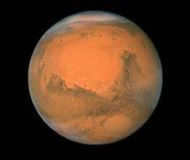
Mars – Mars, the red planet, is a relatively small planet that can be observed by the naked eye. The presence of formations resembling riverbeds and evidence of canyons and oceans suggest that Mars shares similarities in structure with Earth. Scientists have hypothesized the existence of water on Mars, similar to our own planet. Additionally, Mars has an atmosphere, although its oxygen content is significantly lower at only 0.13%. The surface of Mars also experiences much lower atmospheric pressure compared to Earth. continue reading
Mars’ Satellites: Phobos and Deimos
Mars is orbited by two satellites – Phobos and Deimos. These satellites have relatively small diameters and their surfaces appear irregular, making them resemble asteroids. Phobos has a diameter of 27km, while Deimos has a diameter of 15km. learn more
The fifth planet from the Sun, Jupiter

Jupiter is the largest planet in the Solar System, composed mostly of swirling gas layers. With a diameter of 143,000 km, Jupiter is significantly larger than Earth, which has a diameter of 13,000 km. Despite its massive size, Jupiter rotates rapidly on its axis, completing one rotation every 9 hours and 50 minutes, much faster than Earth. This fast rotation causes the poles of the planet to be compressed while the equator is stretched. Read more
Jupiter’s rings and satellites: Europa, Io, Ganymede, Callisto, and others. The planet Jupiter is surrounded by a family of 79 satellites (as of 2018), each with its own unique characteristics. Read more
The planet Saturn
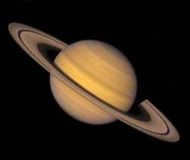
Saturn is a truly extraordinary and stunning planet with distinctive rings that can be observed with a regular telescope. However, what sets Saturn apart is its remarkably low density, which is even lower than that of water. If we were to imagine an ocean on Saturn’s surface, we would witness the mesmerizing spectacle of its waters gently crashing against the planet’s terrain. For further details, please refer to our additional information.
The rings and satellites of Saturn: Titan, Enceladus, and others.
It’s not just Saturn that possesses distinctive rings, but also other colossal planets. The rings surrounding Saturn are particularly noticeable due to their composition of billions of tiny particles that encircle the planet. Apart from its numerous rings, Saturn boasts 82 satellites (as of 2020), including Titan, which holds the title of the solar system’s largest satellite with a diameter of 5000km. read more
Uranus: A Unique Planet in the Solar System
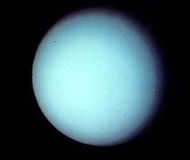
Uranus – this distinct celestial body can be observed in hues of blue and green as it absorbs hydrogen and methane in the infrared spectrum. There are powerful winds that rage on the surface of Uranus, reaching astonishing speeds of up to 600 km/h, following the planet’s rotation. What sets Uranus apart is its significantly inclined axis of rotation, which is nearly parallel to the plane of the ecliptic. As a result, the planet’s poles can only be partially visible from Earth, and even then, only for a period of 42 years. One prevailing theory to explain this phenomenon suggests that there may have been a collision with a massive celestial object in the planet’s past. read more
The moons and orbiting bodies of Uranus: Titania, Oberon, and more.
Uranus, the celestial body, boasts a total of 27 orbiting bodies (all of which have been discovered as of 2013). Similar to its planetary counterparts, Uranus is encircled by delicate rings that possess minimal reflective properties, rendering them invisible until their accidental discovery in 1977. Find out more.
Neptune
Neptune is the eighth and farthest known planet from the Sun in the Solar System. It is the fourth-largest planet by diameter and the third-largest by mass. Among the gaseous planets in the solar system, Neptune is the most dense. Neptune is 17 times the mass of Earth and is slightly more massive than its near-twin Uranus, which is 15 times the mass of Earth but not as dense. Neptune orbits the Sun once every 164.8 years.
Neptune is named after the Roman god of the sea and has the astronomical symbol ♆, a stylized version of the god Neptune’s trident.
Neptune is not visible to the naked eye and is the only planet in the Solar System found by mathematical prediction rather than by empirical observation. Unexpected changes in the orbit of Uranus led Alexis Bouvard to deduce that its orbit was subject to gravitational perturbation by an unknown planet. Neptune was subsequently observed with a telescope on September 23, 1846, by Johann Galle within a degree of the position predicted by Urbain Le Verrier. Its largest moon, Triton, was discovered shortly thereafter, though none of the planet’s remaining known 14 moons were located telescopically until the 20th century. The planet’s distance from Earth gives it a very small apparent size, making it challenging to study with Earth-based telescopes.
Neptune was visited by Voyager 2, when it flew by the planet on August 25, 1989. The advent of the Hubble Space Telescope and large ground-based telescopes with adaptive optics has recently allowed for additional detailed observations from afar.
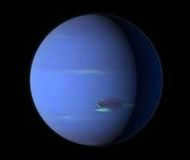
Neptune – This celestial body, similar to Uranus, consists of a gaseous substance primarily composed of water, methane, and ammonia. The planet’s distinctive blue color is due to the high concentration of methane in its atmosphere. Above Neptune’s surface, one can observe extensive clouds comprised of ammonia and water, with a dense layer of methane clouds situated above them. Moreover, the planet’s atmosphere contains hydrogen and helium. Notably, the atmosphere itself is highly active, characterized by powerful winds blowing at speeds exceeding 2000 km/h, resulting in the formation of colossal storms comparable in size to our own planet. learn more
Neptune’s satellites and rings: Among Neptune’s known satellites are Triton, Nereid, and several others.
Prior to the exploration of Neptune by the Voyager 2 spacecraft, scientists were aware of two satellites orbiting the planet – Triton and Nereid. One fascinating feature of Triton is its retrograde orbit, meaning it moves in the opposite direction of most other satellites. Additionally, Voyager 2 discovered peculiar volcanoes on Triton that emitted nitrogen gas like geysers, releasing a dark mass into the atmosphere that spanned many kilometers. During its mission in 1989, Voyager 2 also uncovered six more satellites around Neptune. As of 2013, a total of 14 satellites have been identified orbiting Neptune. read more
Space entities within the Solar System
Comets

Comets – Known as comets, these celestial bodies roam the universe at astonishing speeds and follow massive orbits. They consist of a bright, luminous head and an incredibly long tail plume that can stretch up to 100 million km. These solitary wanderers can spend extended periods of time outside of our solar system before returning and hurtling closer to our planet, traversing vast distances along their orbit. read more
Space Rocks
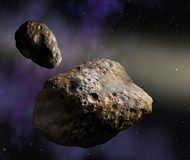
Asteroids are similar to planets, but they are much smaller in size. They orbit around the Sun and have a rocky surface. Some of their characteristics resemble those of small planets, which is why they are sometimes referred to as “minor planets”. The largest concentration of asteroids can be found between Mars and Jupiter in an area known as the “asteroid belt”. These asteroids come in various sizes, ranging from small ones with a diameter of just a few tens of centimeters, similar to a kitchen pot, to large ones with a diameter of 250 kilometers or more. The largest known asteroid, Ceres, has a diameter of 1000 kilometers. Read more
Space Rocks: Meteorites

Meteorites are often referred to as shooting stars, and they can be seen during meteor showers that occur every year in early August and at other times throughout the year. It is possible to observe these “shooting stars” with the naked eye, as they briefly flicker like sparks and streak across the night sky in a fraction of a second. These shooting stars are actually small particles of cosmic dust that fall to Earth. As they vaporize in the dense layers of the atmosphere, they leave behind a short-lived bright trace in the starry sky. If you would like to learn more about meteorites, please read on.
Distant celestial bodies of the solar system
Pluto

Pluto is the most remote icy planet in the Solar System. It has characteristics that could classify it as a terrestrial planet, but in 2006, the International Astronomical Union (IAU) reclassified Pluto as a dwarf planet, along with Erida and Ceres. Pluto consists of a rocky core with possible ice content, an icy mantle, and a crust that forms its surface. It is believed that beneath the top layer lies a thick mass of ice, over 200 kilometers thick. Therefore, the planet is primarily composed of water and methane components. Read more
There are a number of satellites that orbit around Pluto, including Charon, Hydra, Nekta, P4, and P5. Currently, Pluto is known to have a total of 5 satellites. The largest of these satellites is Charon, while the other four are smaller in size. One unique feature of Pluto’s satellite Charon is its small size in comparison to the satellites of other planets. Additionally, Charon is positioned very close to Pluto and orbits the planet at the same speed that Pluto rotates on its axis. As a result, Charon always remains in the same position above the planet. For more information, click here.
The Edgeworth-Kuiper Belt and the Oort Cloud

The Edgeworth-Keuper Belt and the Oort cloud. – In the outer regions of Neptune’s orbit lie the distant components of our Solar System, known as “trans-Neptunian objects”, which include objects from the Kuiper Belt, small celestial bodies, dwarf planets like the Pluto-Haron system, the dwarf planet Erida, and other objects primarily composed of ice. Even further away lies the dispersed disk, where objects are widely scattered. And even farther, at a distance of nearly 1 light-year, exists the Oort cloud, which may serve as the fundamental material for the creation of comets.
Small celestial bodies
Are you familiar with dwarf planets? These are small celestial bodies that are similar to planets but don’t meet all the criteria to be classified as such. They are not massive enough to have cleared their orbits of other debris, which is one of the key characteristics of a planet. Instead, they share their orbits with other objects, like asteroids and comets. Dwarf planets can be found in various regions of the solar system, such as the Kuiper Belt and the asteroid belt. Some well-known examples of dwarf planets include Pluto, Eris, and Haumea. These fascinating objects provide valuable insights into the formation and evolution of our solar system.

The solar system is not limited to just eight planets; it contains many more celestial objects known as dwarf planets. These dwarf planets have orbits that extend beyond Neptune and move in large elliptical paths, sometimes taking more than 4000 years to complete one revolution around the Sun. While we have already discovered several dwarf planets, there may still be many more waiting to be found.
Exoplanets: Worlds beyond our solar system

Planetary Systems in Distant Solar Systems – In distant galaxies that are light years away from our own, there are stars that have their own planetary systems. These planets, known as “exoplanets,” orbit around their own stars. With the help of advanced technology, scientists are able to discover more and more of these planets and their corresponding planetary systems. It is estimated that there could be over 100 billion such planets in the Milky Way galaxy alone, with up to 20 billion having similar characteristics to Earth’s surface. Some of these planets may even support life. read more
About 4.57 billion years ago, our solar system came into existence through the gravitational compression of a gas-dust cloud.
Composition of the Solar System
What is the total number of planets in our solar system? – 8.
Comprising the solar system are eight primary planets and five smaller planets that revolve around the sun on a relatively even plane.
Arranged in sequence from the Sun, the planets are named
Mercury, Venus, Earth, Mars, Jupiter, Saturn, Uranus, and Neptune.
Planet Classification
Planets are categorized based on their physical characteristics into two groups: terrestrial planets and giant planets.
The terrestrial planets, also known as inner planets, are relatively small and dense, consisting mainly of metals and minerals. This group includes:
The giant planets, or outer planets, are significantly larger than the other planets and are primarily composed of gases and ice. The giant planets are:
Former celestial body
Pluto used to be included in the category as well.
Pluto was the final discovery among the planets within our solar system – it was only identified by American astronomers in 1930.
In 2006, it was eliminated from the roster of planets in our solar system.
Pluto was stripped of its planetary status due to the fact that it had not cleared its orbital path of other celestial objects with its gravitational force – although this assertion is only found in a solitary scientific paper from the early 19th century.
In 2016, researchers announced a 90 percent likelihood of a ninth planet’s existence on the outskirts of our solar system.

Figure. The arrangement of the solar system
Which planet is the largest?
The smallest planet in the solar system is Mercury (with a diameter of 4,878 kilometers). It is also the closest at a distance of 0.387 astronomical units (which is equivalent to 58 million kilometers).
The hottest planet in the solar system is Venus. Its surface temperature exceeds 400 degrees Celsius.
The largest planet in the solar system is Jupiter (with a diameter of 139,800 kilometers).
The coldest planet in the solar system is Uranus (its temperature can drop to -224 degrees Celsius). It is also the lightest planet, weighing 8.68-10^25 kilograms (equivalent to 14.5 Earth masses).

